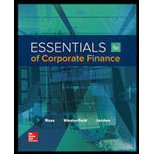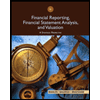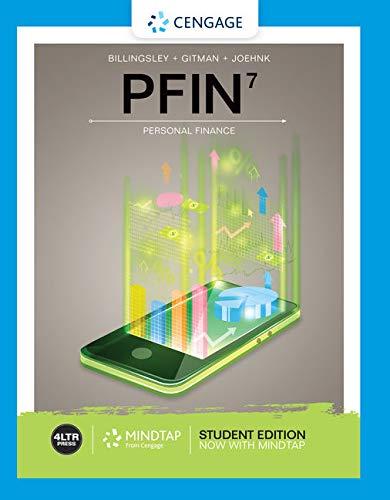
ESSENTIALS CORPORATE FINANCE + CNCT A.
9th Edition
ISBN: 9781259968723
Author: Ross
Publisher: MCG CUSTOM
expand_more
expand_more
format_list_bulleted
Concept explainers
Textbook Question
Chapter 11, Problem 1CTCR
Diversifiable and Nondiversifiable Risks. In broad terms, why is some risk diversifiable? Why are some risks nondiversifiable? Does it follow that an investor can control the level of unsystematic risk in a portfolio, but not the level of systematic risk?
Expert Solution & Answer
Want to see the full answer?
Check out a sample textbook solution
Students have asked these similar questions
You plan to save $X per year for 6 years, with your first savings contribution in 1 year. You and your heirs then plan to withdraw
$43,246 per year forever, with your first withdrawal expected in 7 years. What is X if the expected return per year is 18.15 percent per
year?
Input instructions: Round your answer to the nearest dollar.
59
$
Are there assets for which a value might be considered to be hard to determine?
You plan to save $X per year for 7 years, with your first savings contribution in 1 year. You and your heirs then plan to make annual
withdrawals forever, with your first withdrawal expected in 8 years. The first withdrawal is expected to be $43,596 and all subsequent
withdrawals are expected to increase annually by 1.84 percent forever. What is X if the expected return per year is 11.34 percent per
year?
Input instructions: Round your answer to the nearest dollar.
$
Chapter 11 Solutions
ESSENTIALS CORPORATE FINANCE + CNCT A.
Ch. 11.1 - How do we calculate the expected return on a...Ch. 11.1 - Prob. 11.1BCQCh. 11.2 - What is a portfolio weight?Ch. 11.2 - How do we calculate the expected return on a...Ch. 11.2 - Is there a simple relationship between the...Ch. 11.3 - Prob. 11.3ACQCh. 11.3 - Prob. 11.3BCQCh. 11.4 - Prob. 11.4ACQCh. 11.4 - Prob. 11.4BCQCh. 11.5 - Prob. 11.5ACQ
Ch. 11.5 - Prob. 11.5BCQCh. 11.5 - Prob. 11.5CCQCh. 11.5 - Prob. 11.5DCQCh. 11.6 - Prob. 11.6ACQCh. 11.6 - Prob. 11.6BCQCh. 11.6 - How do you calculate a portfolio beta?Ch. 11.6 - True or false: The expected return on a risky...Ch. 11.7 - Prob. 11.7ACQCh. 11.7 - Prob. 11.7BCQCh. 11.7 - Prob. 11.7CCQCh. 11.8 - If an investment has a positive NPV, would it plot...Ch. 11.8 - Prob. 11.8BCQCh. 11 - What does variance measure?Ch. 11 - Prob. 11.2CCh. 11 - What is the equation for total return?Ch. 11 - Prob. 11.4CCh. 11 - Prob. 11.5CCh. 11 - By definition, what is the beta of the average...Ch. 11 - Section 11.7What does the security market line...Ch. 11 - Diversifiable and Nondiversifiable Risks. In broad...Ch. 11 - Information and Market Returns. Suppose the...Ch. 11 - Systematic versus Unsystematic Risk. Classify the...Ch. 11 - Systematic versus Unsystematic Risk. Indicate...Ch. 11 - Prob. 5CTCRCh. 11 - Prob. 6CTCRCh. 11 - Prob. 7CTCRCh. 11 - Beta and CAPM. Is it possible that a risky asset...Ch. 11 - Prob. 9CTCRCh. 11 - Earnings and Stock Returns. As indicated by a...Ch. 11 - Determining Portfolio Weights. What are the...Ch. 11 - Portfolio Expected Return. You own a portfolio...Ch. 11 - Prob. 3QPCh. 11 - Prob. 4QPCh. 11 - Prob. 5QPCh. 11 - Prob. 6QPCh. 11 - Calculating Returns and Standard Deviations. Based...Ch. 11 - Prob. 8QPCh. 11 - Prob. 9QPCh. 11 - LO1, LO2 10.Returns and Standard Deviations....Ch. 11 - Calculating Portfolio Betas. You own a stock...Ch. 11 - Calculating Portfolio Betas. You own a portfolio...Ch. 11 - Using CAPM. A stock has a beta of 1.23, the...Ch. 11 - Using CAPM. A stock has an expected return of 11.4...Ch. 11 - Using CAPM. A stock has an expected return of 10.9...Ch. 11 - Prob. 16QPCh. 11 - Using CAPM. A stock has a beta of 1.23 and an...Ch. 11 - Using the SML. Asset W has an expected return of...Ch. 11 - Reward-to-Risk Ratios. Stock Y has a beta of 1.20...Ch. 11 - Prob. 20QPCh. 11 - Prob. 21QPCh. 11 - Prob. 22QPCh. 11 - Prob. 23QPCh. 11 - Calculating Portfolio Weights and Expected Return....Ch. 11 - Portfolio Returns and Deviations. Consider the...Ch. 11 - Prob. 26QPCh. 11 - Analyzing a Portfolio. You want to create a...Ch. 11 - Prob. 28QPCh. 11 - SML. Suppose you observe the following situation:...Ch. 11 - Systematic versus Unsystematic Risk. Consider the...Ch. 11 - Beta is often estimated by linear regression. A...
Knowledge Booster
Learn more about
Need a deep-dive on the concept behind this application? Look no further. Learn more about this topic, finance and related others by exploring similar questions and additional content below.Similar questions
- You plan to save $41,274 per year for 4 years, with your first savings contribution later today. You then plan to make X withdrawals of $41,502 per year, with your first withdrawal expected in 4 years. What is X if the expected return per year is 8.28 percent per year? Input instructions: Round your answer to at least 2 decimal places.arrow_forwardYou plan to save $X per year for 10 years, with your first savings contribution in 1 year. You then plan to withdraw $58,052 per year for 9 years, with your first withdrawal expected in 10 years. What is X if the expected return is 7.41 percent per year? Input instructions: Round your answer to the nearest dollar. 69 $arrow_forwardYou plan to save $X per year for 7 years, with your first savings contribution later today. You then plan to withdraw $30,818 per year for 5 years, with your first withdrawal expected in 8 years. What is X if the expected return per year is 6.64 percent per year? Input instructions: Round your answer to the nearest dollar. $arrow_forward
- You plan to save $24,629 per year for 8 years, with your first savings contribution in 1 year. You then plan to withdraw $X per year for 7 years, with your first withdrawal expected in 8 years. What is X if the expected return per year is 5.70 percent per year? Input instructions: Round your answer to the nearest dollar. $ SAarrow_forwardYou plan to save $15,268 per year for 7 years, with your first savings contribution later today. You then plan to withdraw $X per year for 9 years, with your first withdrawal expected in 8 years. What is X if the expected return per year is 10.66 percent per year? Input instructions: Round your answer to the nearest dollar. GA $arrow_forwardYou plan to save $19,051 per year for 5 years, with your first savings contribution in 1 year. You then plan to make X withdrawals of $30,608 per year, with your first withdrawal expected in 5 years. What is X if the expected return per year is 14.61 percent per year? Input instructions: Round your answer to at least 2 decimal places.arrow_forward
- What is the value of a building that is expected to generate no cash flows for several years and then generate annual cash flows forever if the first cash flow is expected in 10 years, the first cash flow is expected to be $49,900, all subsequent cash flows are expected to be 3.42 percent higher than the previous cash flow, and the cost of capital is 15.90 percent per year? Input instructions: Round your answer to the nearest dollar. $arrow_forwardYou plan to save $X per year for 8 years, with your first savings contribution later today. You and your heirs then plan to make annual withdrawals forever, with your first withdrawal expected in 9 years. The first withdrawal is expected to be $29,401 and all subsequent withdrawals are expected to increase annually by 3.08 percent forever. What is X if the expected return per year is 9.08 percent per year? Input instructions: Round your answer to the nearest dollar. 59 $arrow_forwardYou own investment A and 10 bonds of bond B. The total value of your holdings is $12,185.28. Bond B has a coupon rate of 18.82 percent, par value of $1000, YTM of 15.36 percent, 7 years until maturity, and semi-annual coupons with the next coupon expected in 6 months. Investment A is expected to pay $X per year for 12 years, has an expected return of 19.64 percent, and is expected to make its first payment later today. What is X? Input instructions: Round your answer to the nearest dollar. 59 $arrow_forward
- You plan to save $X per year for 8 years, with your first savings contribution later today. You then plan to withdraw $43,128 per year for 6 years, with your first withdrawal expected in 8 years. What is X if the expected return per year is 13.14 percent per year? Input instructions: Round your answer to the nearest dollar. 59 $arrow_forwardYou plan to save $X per year for 6 years, with your first savings contribution in 1 year. You then plan to withdraw $20,975 per year for 8 years, with your first withdrawal expected in 7 years. What is X if the expected return is 13.29 percent per year? Input instructions: Round your answer to the nearest dollar. 59 $arrow_forwardYou plan to save $X per year for 7 years, with your first savings contribution later today. You and your heirs then plan to withdraw $31,430 per year forever, with your first withdrawal expected in 8 years. What is X if the expected return per year is 14.95 percent per year per year? Input instructions: Round your answer to the nearest dollar. 6A $arrow_forward
arrow_back_ios
SEE MORE QUESTIONS
arrow_forward_ios
Recommended textbooks for you
 EBK CONTEMPORARY FINANCIAL MANAGEMENTFinanceISBN:9781337514835Author:MOYERPublisher:CENGAGE LEARNING - CONSIGNMENT
EBK CONTEMPORARY FINANCIAL MANAGEMENTFinanceISBN:9781337514835Author:MOYERPublisher:CENGAGE LEARNING - CONSIGNMENT Financial Reporting, Financial Statement Analysis...FinanceISBN:9781285190907Author:James M. Wahlen, Stephen P. Baginski, Mark BradshawPublisher:Cengage Learning
Financial Reporting, Financial Statement Analysis...FinanceISBN:9781285190907Author:James M. Wahlen, Stephen P. Baginski, Mark BradshawPublisher:Cengage Learning Intermediate Financial Management (MindTap Course...FinanceISBN:9781337395083Author:Eugene F. Brigham, Phillip R. DavesPublisher:Cengage Learning
Intermediate Financial Management (MindTap Course...FinanceISBN:9781337395083Author:Eugene F. Brigham, Phillip R. DavesPublisher:Cengage Learning Pfin (with Mindtap, 1 Term Printed Access Card) (...FinanceISBN:9780357033609Author:Randall Billingsley, Lawrence J. Gitman, Michael D. JoehnkPublisher:Cengage Learning
Pfin (with Mindtap, 1 Term Printed Access Card) (...FinanceISBN:9780357033609Author:Randall Billingsley, Lawrence J. Gitman, Michael D. JoehnkPublisher:Cengage Learning

EBK CONTEMPORARY FINANCIAL MANAGEMENT
Finance
ISBN:9781337514835
Author:MOYER
Publisher:CENGAGE LEARNING - CONSIGNMENT

Financial Reporting, Financial Statement Analysis...
Finance
ISBN:9781285190907
Author:James M. Wahlen, Stephen P. Baginski, Mark Bradshaw
Publisher:Cengage Learning


Intermediate Financial Management (MindTap Course...
Finance
ISBN:9781337395083
Author:Eugene F. Brigham, Phillip R. Daves
Publisher:Cengage Learning

Pfin (with Mindtap, 1 Term Printed Access Card) (...
Finance
ISBN:9780357033609
Author:Randall Billingsley, Lawrence J. Gitman, Michael D. Joehnk
Publisher:Cengage Learning
Investment Risk and Its Types; Author: EconClips;https://www.youtube.com/watch?v=qDZw_iKzJlI;License: Standard Youtube License